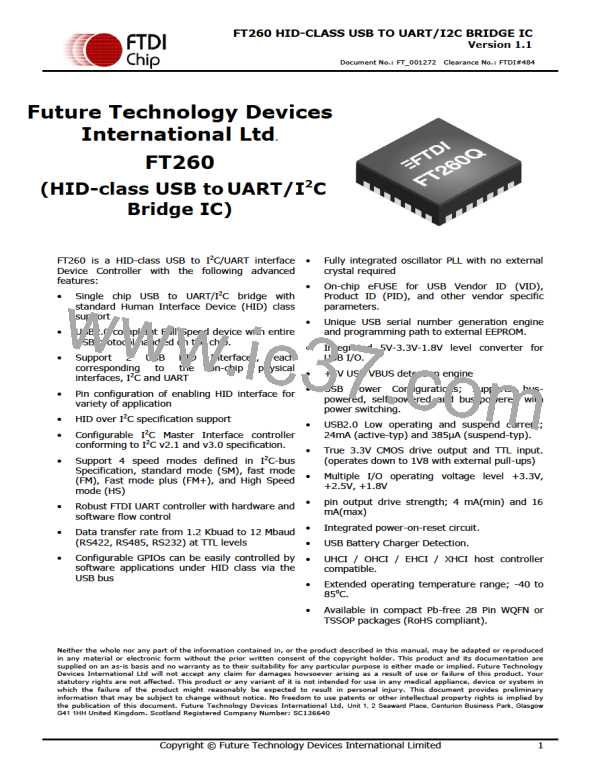FT260 HID-CLASS USB TO UART/I2C BRIDGE IC
Version 1.1
Document No.: FT_001272 Clearance No.: FTDI#484
5.2 I2C Bus Interface
I2C (Inter Integrated Circuit) is a multi-master serial bus invented by Philips. I2C uses two bi-directional
open-drain wires called serial data (SDA) and serial clock (SCL). Common I²C bus speeds are standard
mode (SM) with a bit rate up to 100 Kbit/s, fast mode (FM) with a bit rate up to 400 Kbit/s, Fast mode
plus (FM+) with a bit rate up to 1 Mbit/s, and High Speed mode (HS) with the bit rate up to 3.4 Mbit/s.
An I2C bus node can operate either as a master or a slave:
.
.
Master node
Slave node
– issues the clock and addresses slaves
– receives the clock line and address.
The FT260 operates as an I2C master and is capable of being set to the speed modes defined in the I2C
bus specification. Besides the speed mode defined in the I2C standard specification, the I2C controller of
the FT260 can support flexible SCL frequencies defined by the following function
퐎퐩퐞퐫퐚퐭퐢퐧퐠 퐂퐥퐨퐜퐤 퐅퐫퐞퐪퐮퐞퐧퐜퐲
푺푪푳 푭풓풆풒 =
푴 = ퟔ 풐풓 ퟖ; 푵 = ퟏ, ퟐ, ퟑ, … … , ퟏퟐퟕ
(
)
퐌∗ 퐍+ퟏ
When the target frequency is below 100 KHz or higher than 1MHz, M will be equal to 8; otherwise, M will
be equal to 6. For example, to generate a 3MHz frequency on SCL, M will be selected as 8. With the
operating clock frequency equal to 48MHz, the user can set N as 1. The SCL frequency of the I2C master
mode for the FT260 can be set via USB commands. Details can be referenced in the FT260 Application
Notes.
5.2.1 I2C Pin Definition
The I2C function in the FT260 is an I2C master device. It is enabled by default when the FT260 is powered
up and the operating speed on the I2C bus is designed as 60 KHz for connectivity to most of the external
I2C slave devices. The I2C pins of the FT260 are
Clock – SCL (DIO5, pin 12 @ WQFN28), as clock output with open-drain design
Data – SDA (DIO6, pin 13 @ WQFN28), command/address/data transfer between master and
slave with open-drain design
5.2.2 I2C Bus Protocol
There are four potential modes of operation for a given bus device, although most devices only use a
single role (Master or Slave) and its two modes (Transmit and Receive):
.
.
.
.
Master transmit – sending data to a slave
Master receive – receiving data from a slave
Slave transmit – sending data to a master
Slave receive – receiving data from the master
Copyright © Future Technology Devices International Limited
18

 FTDI [ FUTURE TECHNOLOGY DEVICES INTERNATIONAL LTD. ]
FTDI [ FUTURE TECHNOLOGY DEVICES INTERNATIONAL LTD. ]